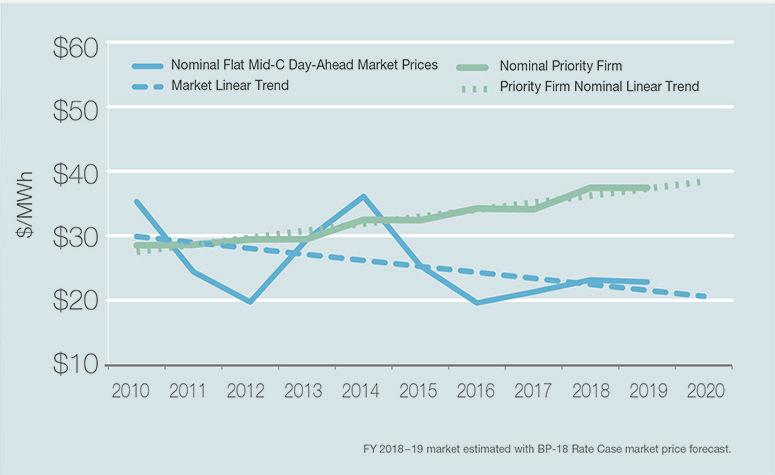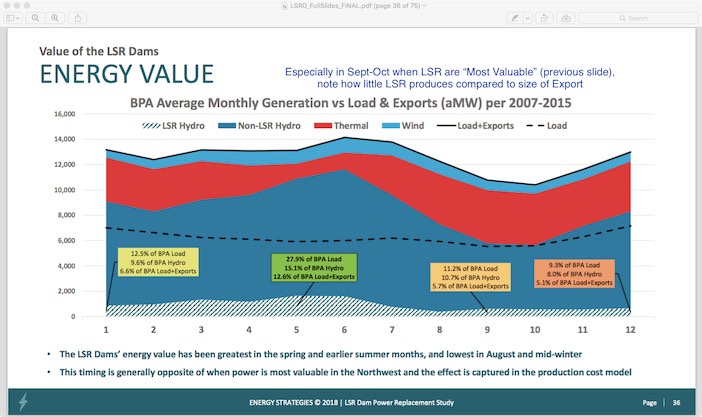forum
library
tutorial
contact

Salmon Advocates See Potential
for Snake River Dam Removal
by Greg Moore
Idaho Mountain Express, March 20, 2019
|
the film forum library tutorial contact |

|
Salmon Advocates See Potential
by Greg Moore
|
Economics may demand it
 Changes in the economics of hydropower generation in the Pacific Northwest are giving anadromous fish advocates optimism that four dams on the lower Snake River could soon be removed. The dams are widely blamed for being the main cause of salmon and steelhead declines in Idaho since they went into operation in the 1960s and '70s.
Changes in the economics of hydropower generation in the Pacific Northwest are giving anadromous fish advocates optimism that four dams on the lower Snake River could soon be removed. The dams are widely blamed for being the main cause of salmon and steelhead declines in Idaho since they went into operation in the 1960s and '70s.
"The lower Snake River dams are not economically viable in the larger context of what's happening in the Pacific Northwest," said river guide and Idaho Conservation League board member Jim Norton during a symposium at The Community Library in Ketchum on March 13-14. "I've never been more convinced that this is the moment."
In an interview, Idaho Rivers United Executive Director Kevin Lewis said he agreed.
The causes of that optimism are a widening spread between the price of Bonneville Power Administration electricity and market rates, looming high maintenance costs at the lower Snake dams and flat demand for power in the region.
"Our power customers have expressed significant concerns that BPA's recent pattern of rising costs and rates is unsustainable," the federal agency states in its "2018-2023 Strategic Plan."
The plan goes on to say that "Bonneville is committed to remaining a cost-effective power supplier, but its cost advantage has eroded. A substantial challenge is low wholesale power prices caused by persistently low natural gas prices and ever-increasing renewable energy expansion during a time when electric loads remain flat. Supply is outpacing demand. ..."
The plan also notes that BPA "faces cost pressure from maintaining aging generation infrastructure" and "increasing costs to meet fish and wildlife obligations."
The most significant maintenance cost coming up is $1 billion to replace 22 of 24 turbines on the four Snake River dams by 2035, Norton told the audience in a mostly filled library lecture hall last Wednesday night.
According to the strategic plan, fish and wildlife costs account for about 25 percent of BPA's direct power costs; combined with the financial impacts of spill, those costs account for about one-third of BPA's power rates.
"They are on their way to going effectively broke, if it weren't for their access to capital markets [to borrow money]," Norton said. "The long-term trend is against them."
A crucial time for BPA will come in 2028, when all its 20-year power-sale contracts with its 142 public-utility customers expire.
During a presentation in Portland in March 2018, BPA Administrator Elliott Mainzer noted that the agency's power price is close to $10 per megawatt-hour over the average wholesale market price, adding that "if that spread opens up more I think we're going to look at some significant problems" keeping customers, who will be free to buy power from other suppliers after 2028.
Norton equated the potential situation to a run on the bank.
"If a couple of large customers decide to exit together, it could be catastrophic for spreading the cost to other ratepayers in the system," he said. "If people start exiting, everyone's going to race to get out the door."
Norton said BPA has run down its cash reserves from $900 million in 2006 to about zero now. It has stayed afloat due to borrowing, primarily from the U.S. government.
At the end of 2017, BPA had consumed $5 billion of its borrowing authority, leaving $2.7 billion remaining, the 2018-23 Strategic Plan states.
"Based on projections from BPA's most recent rate filing, this source of financing will be depleted by 2023, putting BPA's future capital program at risk," the plan states. "To continue investing in and maintaining the tremendously valuable federal power and transmission assets, BPA will need to look beyond its traditional financing source and consider an ‘all of the above' capital financing strategy."
Mainzer said during his presentation in Portland that he's "not in a panic mode, but I'm in a very, very significant sense of urgency."
This looks like a good time, Norton and other conservationists say, for BPA to unload poorly performing assets. On that list could be the Snake River dams.
Those dams were built primarily to create a 140-mile-long water route for barges to transport grain from Lewiston, Idaho, on its way to Portland, Ore. They produce far less electricity than do the four big dams on the lower Columbia River. In addition, the run-of-the-river dams on the Snake produce about half their annual power during spring runoff, outside of the peak demand season during winter.
 "They are contributing to what has become a problematic surplus for the federal power family," Norton said.
"They are contributing to what has become a problematic surplus for the federal power family," Norton said.
Most of that surplus had been sold to California, Norton said, but since 2008 that state has been installing a lot of solar power, greatly reducing demand there.
Norton said that if the lower Snake dams are removed, they will not immediately need to be replaced by other sources of power. He said BPA's projection of energy surplus in the region by 2028 is close to the total firm winter production of the four lower Snake River dams. According to the U.S. Energy Information Administration, "firm power" is power "available at all times during the period covered by a guaranteed commitment to deliver, even under adverse conditions."
"The Pacific Northwest is awash in power," he said.
Idaho Rivers United Director Lewis said in an interview that barge traffic on the lower Snake has dropped by half over the past 20 years. He said farmers co-ops in the Palouse, near Lewiston, have built several "unit loaders," big loops of railroad track to allow trains to be loaded with grain. That allows the grain to be shipped by rail anywhere in the country, and not just to Portland.
"Changing needs, on the agriculture side and on the energy side, are making the dams obsolete," he said.
Despite its admission of challenging times, the BPA expresses optimism that its carbon-free power will continue to be valued as part of efforts to combat global warming.
In fall 2016, the BPA (which sells the power from the dams), the U.S. Army Corps of Engineers (which operates the dams) and the Bureau of Reclamation began a Columbia River System Operations Review to update their long-term plans. The review includes analysis of navigation, hydropower, irrigation and fish conservation. According to the BPA 2018-2023 Strategic Plan, the review will also produce a recommendation on the future of the lower Snake River dams. A draft EIS available for public comment is scheduled to be completed by March 2020 and a final EIS by Sept. 30, 2020.
Excellent habitat remainsRuss Thurow, a fisheries biologist at the U.S. Forest Service's Rocky Mountain Research Station in Boise, said during his presentation at The Community Library last week that if obstacles to fish migration on the Columbia River system can be reduced, top-quality habitat in the Middle Fork of the Salmon River drainage awaits spawning salmon.
Thurow said the Middle Fork now averages 771 Chinook spawning areas, called redds, but it could support as many as 92,000.
"We have the building blocks to recover those fish," Thurow said. "There's no quit in those fish, so let's not quit on them. If we take actions, they're going to respond."
learn more on topics covered in the film
see the video
read the script
learn the songs
discussion forum
